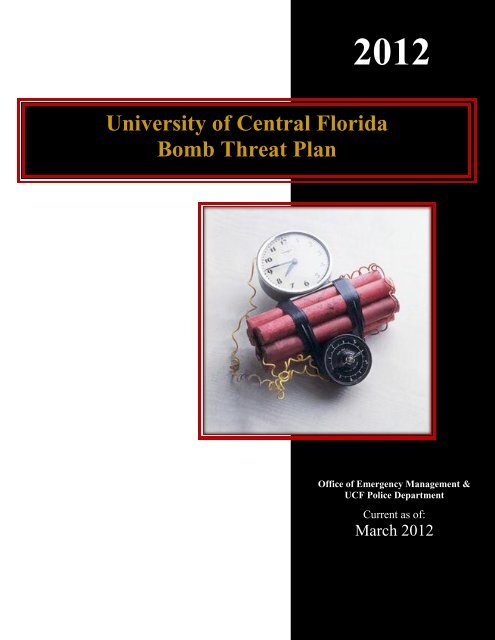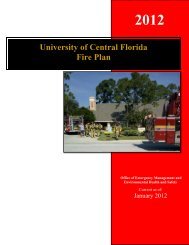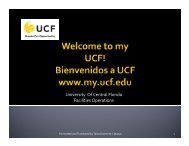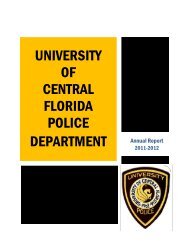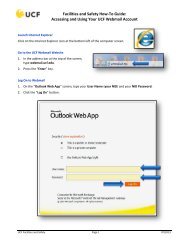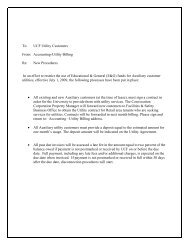University of Central Florida Bomb Threat Plan - UCF Facilities and ...
University of Central Florida Bomb Threat Plan - UCF Facilities and ...
University of Central Florida Bomb Threat Plan - UCF Facilities and ...
Create successful ePaper yourself
Turn your PDF publications into a flip-book with our unique Google optimized e-Paper software.
2012<br />
<strong>University</strong> <strong>of</strong> <strong>Central</strong> <strong>Florida</strong><br />
<strong>Bomb</strong> <strong>Threat</strong> <strong>Plan</strong><br />
Office <strong>of</strong> Emergency Management &<br />
<strong>UCF</strong> Police Department<br />
Current as <strong>of</strong>:<br />
March 2012
<strong>UCF</strong> <strong>Bomb</strong> <strong>Threat</strong> <strong>Plan</strong> 2012<br />
This page is intentionally left blank.<br />
Page 2
<strong>UCF</strong> <strong>Bomb</strong> <strong>Threat</strong> <strong>Plan</strong> 2012<br />
TABLE OF CONTENTS<br />
Chapter 1: INTRODUCTION ................................................................................ 7<br />
Chapter 2: RECEIVING BOMB THREATS ....................................................... 8<br />
2.1. TYPES OF BOMB THREATS ................................................................................................. 8<br />
2.2. PHONED THREATS .............................................................................................................. 8<br />
2.3. WRITTEN THREATS ............................................................................................................ 8<br />
2.4. E-MAILED THREAT ............................................................................................................. 9<br />
2.5. VERBAL THREAT ................................................................................................................ 9<br />
2.6. SOCIAL MEDIA .................................................................................................................... 9<br />
2.7. RUMOR .............................................................................................................................. 10<br />
2.8. <strong>UCF</strong> BOMB THREAT CARD .............................................................................................. 11<br />
Chapter 3: EVACUATION ...................................................................................12<br />
3.1. BUILDING EVACUATIONS .................................................................................................. 12<br />
3.2. THINGS THAT SHOULD NOT BE DONE .............................................................................. 12<br />
3.3. THINGS THAT SHOULD BE DONE ...................................................................................... 12<br />
Chapter 4: SUSPICIOUS PACKAGES ...............................................................14<br />
4.1. PUBLIC AWARENESS ......................................................................................................... 14<br />
4.2. HANDLING THE PACKAGE OR LETTER............................................................................. 16<br />
Chapter 5: RESPONSE PROTOCOLS ...............................................................17<br />
Page 3
<strong>UCF</strong> <strong>Bomb</strong> <strong>Threat</strong> <strong>Plan</strong> 2012<br />
This page is intentionally left blank.<br />
Page 4
<strong>UCF</strong> <strong>Bomb</strong> <strong>Threat</strong> <strong>Plan</strong> 2012<br />
This plan is maintained by the <strong>University</strong> <strong>of</strong> <strong>Central</strong> <strong>Florida</strong> Office <strong>of</strong> Emergency Management.<br />
Any concerns or questions can <strong>and</strong> should be forwarded to <strong>Facilities</strong> & Safety, specifically:<br />
Emergency <strong>Plan</strong>s <strong>and</strong> Programs Coordinator<br />
Office <strong>of</strong> Emergency Management<br />
Phone: (407) 823-0678<br />
Departments Responsible for this plan:<br />
<strong>University</strong> Police<br />
<strong>Facilities</strong> & Safety<br />
o Office <strong>of</strong> Emergency Management<br />
Supersedes:<br />
April 2011 Edition<br />
March 2010 Edition<br />
Pages:<br />
17<br />
Distribution:<br />
Office <strong>of</strong> Emergency Management<br />
<strong>UCF</strong> Police<br />
General Distribution<br />
Notes:<br />
This plan is included in the Comprehensive Emergency Management <strong>Plan</strong> (CEMP), General<br />
Edition.<br />
Page 5
<strong>UCF</strong> <strong>Bomb</strong> <strong>Threat</strong> <strong>Plan</strong> 2012<br />
This page is intentionally left blank.<br />
Page 6
<strong>UCF</strong> <strong>Bomb</strong> <strong>Threat</strong> <strong>Plan</strong> 2012<br />
CHAPTER 1: INTRODUCTION<br />
1.1. The <strong>University</strong> <strong>of</strong> <strong>Central</strong> <strong>Florida</strong> makes safety for faculty, staff, students, <strong>and</strong> visitors a<br />
top priority. In the aftermath <strong>of</strong> school-related incidents, school administrators have been<br />
encouraged to conduct comprehensive security initiatives within their universities. One<br />
<strong>of</strong> the components <strong>of</strong> the Comprehensive Emergency Management <strong>Plan</strong> is the <strong>Bomb</strong><br />
<strong>Threat</strong> <strong>Plan</strong>. A bomb is any device capable <strong>of</strong> producing damage to material, <strong>and</strong> injury<br />
or death to personnel, when detonated. A bomb may be "incendiary," causing fireproducing<br />
heat <strong>and</strong> little explosion; "explosive," causing damage by fragmentation, heat,<br />
<strong>and</strong> blast wave; or “dirty,” causing a release <strong>of</strong> radiological material.<br />
1.2. Homemade bombs are commonly referred to as improvised explosive devices (IED) <strong>and</strong><br />
can vary in size, shape, <strong>and</strong> material. Homemade car bombs are commonly referred to as<br />
vehicle-born improvised explosive devices (VBIED) <strong>and</strong> occur when IEDs are placed<br />
inside a vehicle. Both terms are utilized throughout this plan to replace the term “bomb”<br />
when appropriate.<br />
1.3. In most cases, bomb threats are designed to disrupt the normal business operations <strong>of</strong> the<br />
institution. Additionally, true terrorists are interested in killing or maiming as many<br />
people as possible <strong>and</strong>, therefore, will not typically make phone calls prior to the bomb<br />
going <strong>of</strong>f.<br />
1.4. All bomb threats will be taken seriously. The Police Department <strong>and</strong> Emergency<br />
Management will determine the appropriate course <strong>of</strong> action. Not all bomb threats are<br />
legitimate, <strong>and</strong> evacuation is not always required.<br />
1.5. This plan has been created as a precautionary measure <strong>and</strong> predefined plan to deal with<br />
bomb threats <strong>and</strong> suspicious devices or packages. This plan is designed to have faculty,<br />
staff, students, visitors <strong>and</strong> Public Safety work as a team to ensure a safe environment.<br />
Page 7
<strong>UCF</strong> <strong>Bomb</strong> <strong>Threat</strong> <strong>Plan</strong> 2012<br />
CHAPTER 2: RECEIVING BOMB THREATS<br />
2.1. Types <strong>of</strong> <strong>Bomb</strong> <strong>Threat</strong>s<br />
2.1.1. A bomb threat may be received in a number <strong>of</strong> ways. A threat may be received by<br />
telephone, written message, e-mail, face-to-face interaction, social media, or suspicious<br />
package delivery by mail or messenger, the first being the most frequently used method.<br />
2.1.2. When receiving a threat, pay careful attention to any pertinent details. The person making<br />
a warning or threatening call could reveal enough information about himself or herself so<br />
that the recipient could later identify them.<br />
2.2. Phoned <strong>Threat</strong>s<br />
2.2.1. If you receive a phoned-in threat:<br />
2.2.1.1. Start a recording device, if one is available, or note the caller I.D. number, if<br />
available.<br />
2.2.1.2. Signal another staff member to call 911 <strong>and</strong> then monitor the conversation, if<br />
possible.<br />
2.2.1.3. Transcribe the threat.<br />
2.2.1.4. Fill out as much <strong>of</strong> the <strong>UCF</strong> <strong>Bomb</strong> <strong>Threat</strong> Card (page 10) as possible, including<br />
responses to detailed questions.<br />
2.2.1.5. When the caller hangs up, DO NOT HANG UP THE PHONE. Leave the line<br />
open. Hanging up the phone may trigger the IED.<br />
2.2.1.6. Complete any unanswered questions on the <strong>UCF</strong> <strong>Bomb</strong> <strong>Threat</strong> Card.<br />
2.2.1.7. Be available after the call for the <strong>University</strong> Police <strong>and</strong> the Crisis Response<br />
Team to interview you.<br />
2.3. Written <strong>Threat</strong>s<br />
2.3.1. If you receive a written threat:<br />
2.3.1.1. H<strong>and</strong>le the item as little as possible.<br />
2.3.1.2. Notify <strong>University</strong> Police at 911.<br />
2.3.1.3. Note where the item was found, the date <strong>and</strong> time you found the item, any<br />
situations or conditions surrounding the discovery, <strong>and</strong> any other person who<br />
may have seen the threat.<br />
Page 8
<strong>UCF</strong> <strong>Bomb</strong> <strong>Threat</strong> <strong>Plan</strong> 2012<br />
2.4. E-mailed <strong>Threat</strong><br />
2.4.1. If you receive an e-mailed threat:<br />
2.4.1.1. Notify <strong>University</strong> Police at 911.<br />
2.4.1.2. Print, photograph, or copy down the message. Include the header <strong>of</strong> the e-mail.<br />
2.4.1.3. Save the e-mail, if you know how to do so.<br />
2.4.1.4. Leave the e-mail open until assistance arrives.<br />
2.5. Verbal <strong>Threat</strong><br />
2.5.1. If you receive a verbal threat:<br />
2.5.1.1. Project calmness; move <strong>and</strong> speak slowly, quietly <strong>and</strong> confidently.<br />
2.5.1.2. Notify the <strong>University</strong> Police at 911 as soon as you can safely do so.<br />
2.5.1.3. Note the description <strong>of</strong> the person who made the threat:<br />
2.5.1.3.1. Name, if you know him or her, or if he or she gave you one;<br />
2.5.1.3.2. Vocal distinguishers;<br />
2.5.1.3.3. Sex;<br />
2.5.1.3.4. Type <strong>and</strong> color <strong>of</strong> clothing;<br />
2.5.1.3.5. Body size <strong>and</strong> height;<br />
2.5.1.3.6. Hair, eye <strong>and</strong> skin color; or<br />
2.5.1.3.7. Distinguishing features.<br />
2.5.1.4. Write down the threat exactly as it was communicated to you:<br />
2.5.1.4.1. Exact wording;<br />
2.5.1.4.2. Who made the threat;<br />
2.5.1.4.3. The date <strong>and</strong> time <strong>of</strong> the threat; <strong>and</strong><br />
2.5.1.4.4. Where the person who made the threat is now, if known.<br />
2.5.1.5. Note the direction in which the person who made the threat leaves, <strong>and</strong> report to<br />
the <strong>University</strong> Police at 911.<br />
2.6. Social Media<br />
2.6.1. Due to the overwhelming use <strong>of</strong> social media as primary means <strong>of</strong> communication, bomb<br />
threats may be made by utilizing social media applications such as Facebook or Twitter.<br />
If you see a threat made through social media:<br />
Page 9
<strong>UCF</strong> <strong>Bomb</strong> <strong>Threat</strong> <strong>Plan</strong> 2012<br />
2.7. Rumor<br />
2.6.1.1. Report it to <strong>University</strong> Police at 911.<br />
2.6.1.2. Note the name <strong>of</strong> the person making the threat <strong>and</strong> the application they used to<br />
make it.<br />
2.6.1.3. Record the exact wording <strong>of</strong> the threat as it was posted.<br />
2.6.1.4. Take a screen shot <strong>of</strong> the computer if possible to provide to the <strong>University</strong><br />
Police.<br />
2.7.1. If you overhear a rumor about an IED, a bomb threat, or incident, write down exactly<br />
what you heard, from whom you heard it, <strong>and</strong> then report the rumor to <strong>University</strong> Police<br />
at 911 or (407) 823-5555.<br />
Page 10
<strong>UCF</strong> <strong>Bomb</strong> <strong>Threat</strong> <strong>Plan</strong> 2012<br />
2.8. <strong>UCF</strong> <strong>Bomb</strong> <strong>Threat</strong> Card<br />
Page 11
<strong>UCF</strong> <strong>Bomb</strong> <strong>Threat</strong> <strong>Plan</strong> 2012<br />
CHAPTER 3: EVACUATION<br />
3.1. Building Evacuations<br />
3.1.1. The building, upon receipt <strong>of</strong> threat, may need to be evacuated in a calm <strong>and</strong> orderly<br />
manner, according to the Building Evacuation Policy. Recommended building evacuation<br />
should be no less than 400 feet from the building; however, evacuations due to potential<br />
bombs may require farther distances. Refer to the <strong>Bomb</strong> <strong>Threat</strong> St<strong>and</strong>-Off Distance chart<br />
(Page 12) for more information.<br />
3.1.2. Emergency personnel <strong>and</strong> designated <strong>University</strong> <strong>of</strong>ficials will facilitate evacuation.<br />
Emergency personnel will notify individuals when reentry to the building can be made.<br />
There is no specified time limit for when students <strong>and</strong> faculty will be permitted back into<br />
the isolated area. This will depend solely upon the information received <strong>and</strong> the results <strong>of</strong><br />
the investigation by public safety authorities.<br />
3.2. Things that Should Not be Done<br />
3.2.1. Any one <strong>of</strong> the following events could trigger an explosive device:<br />
3.2.1.1. DO NOT h<strong>and</strong>le any IED, or suspected IED, or suspicious packages.<br />
3.2.1.2. DO NOT allow any faculty, staff, students or visitors access to, or near, the<br />
proximity <strong>of</strong> the IED.<br />
3.2.1.3. DO NOT move the IED or enclose it to minimize effects <strong>of</strong> an explosion.<br />
3.2.1.4. DO NOT use cellular telephones.<br />
3.2.1.5. DO NOT pull the fire alarms to evacuate any buildings, unless specifically<br />
directed to do so by emergency personnel. This may trigger the IED.<br />
3.2.1.6. If an IED is inside a container, DO NOT open the container.<br />
3.3. Things that Should be Done<br />
3.3.1. Student rosters should be kept current. It is possible that the individual who made the<br />
threat is a student, <strong>and</strong> a current list would assist law enforcement.<br />
3.3.2. Any <strong>and</strong> all media inquiries should go through News & Information, at (407) 823-5007.<br />
3.3.3. The <strong>UCF</strong> populous will be notified via <strong>UCF</strong> Alert in the event such notification is<br />
necessary.<br />
Page 12
<strong>UCF</strong> <strong>Bomb</strong> <strong>Threat</strong> <strong>Plan</strong> 2012<br />
3.3.4. The National Counterterrorism Center advises the following distances in the event <strong>of</strong> an<br />
evacuation:<br />
Source: National Counterterrorism Center website<br />
Page 13
<strong>UCF</strong> <strong>Bomb</strong> <strong>Threat</strong> <strong>Plan</strong> 2012<br />
CHAPTER 4: SUSPICIOUS PACKAGES<br />
Source: ATF website<br />
4.1. Public Awareness<br />
4.1.1. Public awareness <strong>of</strong> mail bombs has increased at all levels, including in university<br />
mailrooms <strong>and</strong> <strong>of</strong>fices. The most important thing to remember when finding a suspicious<br />
package or letter is not to touch the item. You should clear the area immediately <strong>and</strong><br />
notify the <strong>University</strong> Police at 911.<br />
4.1.2. To apply proper safety procedures, it is important to know the type <strong>of</strong> mail normally<br />
received <strong>and</strong> look for the following:<br />
4.1.2.1. Mail bombs come in letters, books, <strong>and</strong> packages <strong>of</strong> various sizes, shapes, <strong>and</strong><br />
colors;<br />
Page 14
<strong>UCF</strong> <strong>Bomb</strong> <strong>Threat</strong> <strong>Plan</strong> 2012<br />
4.1.2.2. Letter texture may feel ridged, look uneven or lopsided, or feel bulkier than<br />
normal;<br />
4.1.2.3. Excessive amounts <strong>of</strong> postage may be present—<strong>of</strong>ten far more than needed;<br />
4.1.2.4. The sender is unknown or there is no return address;<br />
4.1.2.5. H<strong>and</strong>written notes appear, such as, “rush,” “personal,” or “private;”<br />
4.1.2.6. The addressee normally does not receive mail at the <strong>of</strong>fice;<br />
4.1.2.7. Cut or pasted homemade labels are used for lettering;<br />
4.1.2.8. The letter or package may emit an odor, have oily stains, or appear to have been<br />
disassembled <strong>and</strong> re-glued;<br />
4.1.2.9. Distorted or foreign writing is present;<br />
4.1.2.10. Resistance or even pressure is felt when trying to remove contents from the<br />
package;<br />
4.1.2.11. Several combinations <strong>of</strong> tape are used to secure the package;<br />
4.1.2.12. Contents <strong>of</strong> the parcel may slosh or sound like liquid; some packages may emit<br />
noises, such as ticking;<br />
4.1.2.13. The package or letter shows a city or state in the postmark that does not match<br />
the return address;<br />
4.1.2.14. The package or letter is marked Foreign Mail, Air Mail <strong>and</strong> Special Delivery;<br />
4.1.2.15. The package has protruding wires or aluminum foil;<br />
4.1.2.16. The package or letter has incorrect titles, or a title but no name; or<br />
4.1.2.17. Misspellings <strong>of</strong> common words are present.<br />
4.1.3. In addition to physical characteristics, consideration should also be given to the listed<br />
factors to help determine the likelihood <strong>of</strong> a threat:<br />
4.1.3.1. Is there a common sense explanation to the letter<br />
4.1.3.2. Have all reasonable explanations been exhausted<br />
4.1.4. If you are unable to allay your suspicions, call the non-emergency police line at (407)<br />
823-5555, or 911 for emergency situations.<br />
Page 15
<strong>UCF</strong> <strong>Bomb</strong> <strong>Threat</strong> <strong>Plan</strong> 2012<br />
4.2. H<strong>and</strong>ling the Package or Letter<br />
4.2.1. If the suspicious letter or package is unopened:<br />
4.2.1.1. Do not open the package. Do not shake or empty the contents <strong>of</strong> any suspicious<br />
envelope or package. Immediately report the incident to the <strong>University</strong> Police.<br />
4.2.1.2. Have everyone vacate the immediate area <strong>and</strong> close any door, or section <strong>of</strong>f the<br />
area, to prevent others from entering.<br />
4.2.1.3. Wash your h<strong>and</strong>s with soap <strong>and</strong> water to prevent spreading any powder or other<br />
chemicals to your face.<br />
4.2.1.4. List all individuals who h<strong>and</strong>led, or were within close proximity to, the<br />
suspicious letter or package.<br />
4.2.2. If the suspicious letter or package is opened:<br />
4.2.2.1. Do not panic. Immediately report the incident to <strong>University</strong> Police at 911.<br />
Follow any instructions given to you by the dispatcher.<br />
4.2.2.2. Do not try to clean up the substance. Cover the spilled contents immediately<br />
with anything (e.g., clothing, paper, trash can), <strong>and</strong> do not remove this cover.<br />
4.2.2.3. Have everyone vacate the room <strong>and</strong> close any door, or section <strong>of</strong>f the area, to<br />
prevent others from entering.<br />
4.2.2.4. Wash your h<strong>and</strong>s with soap <strong>and</strong> water to prevent spreading any <strong>of</strong> the substance<br />
to your face.<br />
4.2.2.5. Remove heavily contaminated clothing as soon as possible, <strong>and</strong> place in a<br />
plastic bag or some other container that can be sealed. This clothing bag should<br />
be given to the emergency responders for proper h<strong>and</strong>ling.<br />
4.2.2.6. Shower with soap <strong>and</strong> water as soon as possible. Do not use bleach or other<br />
disinfectants on your skin.<br />
4.2.2.7. List all individuals who h<strong>and</strong>led, or were within close proximity to, the<br />
suspicious letter or package, especially those who had actual contact with the<br />
substance.<br />
Page 16
<strong>UCF</strong> <strong>Bomb</strong> <strong>Threat</strong> <strong>Plan</strong> 2012<br />
CHAPTER 5: RESPONSE PROTOCOLS<br />
NOTE: The information in this section is For Official Use Only (FOUO) <strong>and</strong> has been<br />
removed for security purposes. Please contact the <strong>UCF</strong> Office <strong>of</strong> Emergency Management<br />
for additional information.<br />
Page 17


